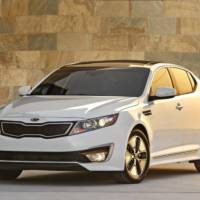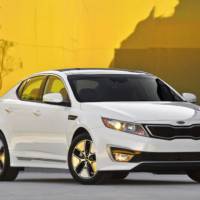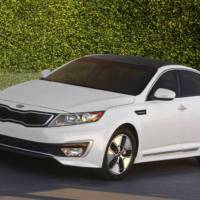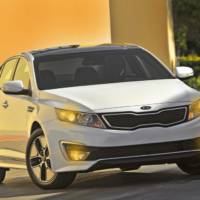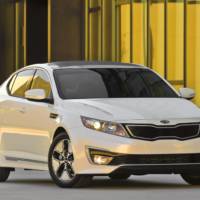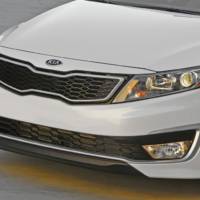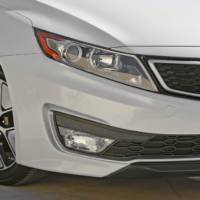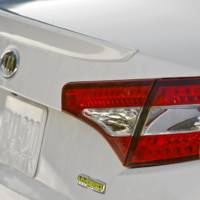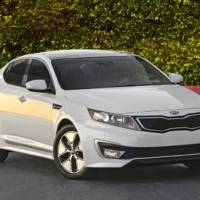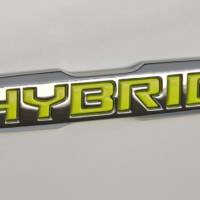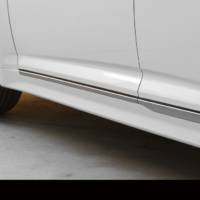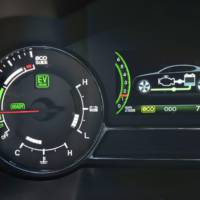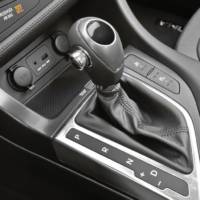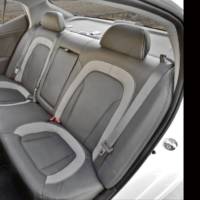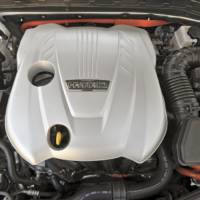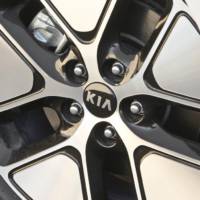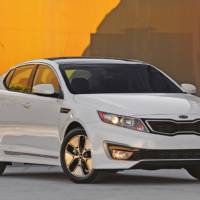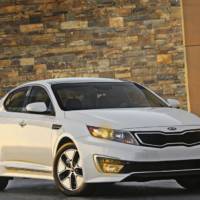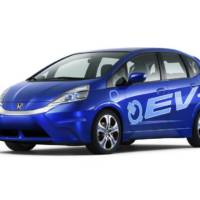A new addition to the Optima range at the 2010 L.A. Auto Show where the Korean manufacturer has revealed the 2011 Kia Optima Hybrid.
With a powertrain much like the one on the Sonata Hybrid, the 2011 Kia Optima Hybrid features a 2.4-litre petrol engine and a 30 kW electric motor combined with a 6-speed automatic gearbox. This system which offers a total of 209 PS and 265 Nm of torque, enables the 2011 Kia Optima Hybrid return an average 40.7 mpg on the the highway while in terms of performance it can accelerate from 0 to 62 mph in 9.2 seconds and reach a top speed of 121 mph.
In terms of appearance the 2011 Kia Optima Hybrid comes with dual chrome-tipped exhausts,
heat-reflective glass, outside mirror turn signal indicators and 16-inch
alloy wheels (17 inch also available).
At the interior the 2011 Kia Optima Hybrid received a new instrument panel with an ECO Guide, a six-way adjustable driver’s seat with
power lumbar support, illuminated vanity mirrors and a trip computer.
The 2011 Kia Optima Hybrid price will be announced as the on sale date approaches.
Kia press release :
* Promises unique blend of high performance and fuel economy
* Zero emissions, electric mode up to 62 mph (100 kph)
* 2.4-litre petrol engine plus 30 kW electric motor
* Introduces state-of-the-art, high power lithium polymer batteries
Kia Motors Corporation today held the world premiere of its all-new Optima Hybrid sedan at the Los Angeles Auto Show. Created primarily with the US market in mind, the latest model in Kia’s design-led transformation employs a truly innovative Kia-developed powertrain that promises to deliver exceptional hybrid performance and 48 mpg class-leading fuel efficiency.
Arriving in US Kia dealer showrooms early next year, the Optima Hybrid is the brand’s first-ever hybrid for North America and uses a ‘full parallel hybrid system’ to deliver a unique blend of performance – acceleration to 62 mph in 9.2 seconds, top speed 121 mph – and economy, achieving a 40.7% mpg improvement compared with a regular Optima.
“Kia Motors is proud to unveil its first-ever hybrid for the North American market,” comments Hyoung-Keun Lee, Vice Chairman of Kia Motors Corporation. “The new Optima Hybrid features a unique architecture and is packed with innovative technologies that demonstrate Kia’s on-going commitment to investing in R&D, and to developing environmentally friendly vehicles for the future.
“Although these new technologies presented our engineers with a series of complex challenges to overcome, the resulting Optima Hybrid delivers a fully automatic, seamless and enjoyable drive, together with real-world benefits for our customers,” adds Mr. Lee.
The Kia Optima Hybrid is equipped with an ingenious, simple and cost-effective ‘parallel hybrid system’. The 2.4-litre petrol engine is mated to a small electric motor and drives the front wheels via a six-speed automatic transmission – without the traditional torque converter. A special clutch is fitted between the engine and motor, enabling the petrol engine to be de-coupled from the powertrain so that Optima can be operated in zero-tailpipe-emissions, full-electric drive mode from standstill up to 62 mph. The system’s configuration does not require a high-capacity electric motor and generator, saving weight and cost.
Automatic, seamless daily driving experience
When setting off the Optima Hybrid operates in Electric Mode. As vehicle speed rises, the Hybrid Starter motor/Generator (HSG) starts the petrol engine and the clutch is closed, allowing the engine to take over the task of propelling the car. The electric motor switches into hybrid operation and serves as both a secondary engine (during full acceleration and hill-climbing) and a generator to recharge the battery pack as necessary. Whenever the car comes to a stop for more than a few seconds, the petrol engine automatically shuts off to completely eliminate tailpipe emissions.
When braking, the electric motor converts kinetic energy into electricity for storage in the battery pack. The 8.5 kW HSG also functions as a generator to re-charge the battery pack if the state of charge is low and when the car is stationary. Throughout the entire driving experience, under all conditions, the entire hybrid operation is automatic and seamless.
An unusually responsive and rewarding drive is guaranteed by the Optima Hybrid’s 30kW Interior Permanent Magnet (IPM) synchronous electric motor, which produces 40.7 ps and 205 Nm of torque from 0-to-1,400 rpm in electric mode, and the combined (electric motor plus petrol engine) hybrid powertrain output of 209 ps and 265 Nm.
Described by Kia engineers as a Transmission-Mounted-Electric-Drive (TMED), the 30kW IPM electric motor sits within the car’s extended transmission casing (between the petrol engine and the automatic gearbox) and is the world’s first oil-cooled system.
Kia’s Optima Hybrid employs a lithium polymer battery array developed in partnership with LG Chem. Lithium polymer offers the benefits of lithium-ion (used in laptops and cell phones), but adds robustness and packaging flexibility, making it ideal for automotive applications. These new batteries provide an optimum balance between power delivery, energy density and thermal stability.
Compared with nickel-metal hydride batteries, lithium polymer batteries weigh 20-to-30% less, occupy 40% less volume and are 10% more efficient. They also hold their charge for 25% longer than nickel metal hydride batteries and are so reliable that the Optima’s battery pack will not require replacing during the vehicle’s lifespan – at least 10 years and 150,000 miles.
The power and energy density of this new type of battery enabled Kia engineers to create a lighter more compact power pack – with a 34 kW output and weighing just 43.6 kg – designed to minimize intrusion of the Optima’s boot space.
The complete hybrid system is controlled by the Optima’s Hybrid Control Unit (HCU) which acts as the car’s mastermind and integrates the smooth operation of the engine’s ECU, transmission’s TCU, battery management system (BMS), low voltage converter (LDC). This brain also gives the Optima a ‘Fail-Safe’ back-up capability and a ‘Limp-home’ mode.
Optimizing the Theta II petrol engine
Taking advantage of the instant and continuously available torque from the electric motor, Kia modified its popular 2.4-litre Theta II engine to operate on an Atkinson cycle, raising the compression ratio by 20% to maximize its efficiency and achieving a 10% fuel saving over a regular Theta engine. This cycle generates a little less torque, but the electric motor compensates for any loss and consequently, the Optima Hybrid’s overall power and torque outputs are greater than the regular model.
For the Optima Hybrid, Kia has modified the six-speed automatic transmission found on the conventional Optima for hybrid application. The traditional torque converter is replaced with an electric motor and a high-efficiency oil pump. This new gearbox allows EV mode operation, maximizes regeneration of kinetic energy during braking and also provides a more responsive drive than a CVT system.
To maximize the Optima Hybrid’s performance and minimize its fuel consumption, special attention has been paid to its aerodynamics. The car is lowered by 5 mm and new features include an ‘active air flap’ in the front grille, smooth underfloor panels, low-drag wheels and low rolling resistance tyres. The drag coefficient is lowered to a remarkable Cd 0.26.
Energy and fuel-saving technologies features in the Optima Hybrid include a regenerative braking system, electric – rather than hydraulic – assisted power steering, and an electric air compressor capable of delivering high air-conditioning performance.
Two independent liquid cooling systems are fitted to the Optima Hybrid powertrain. The standard high-temperature circuit manages engine cooling and passenger compartment heating. The second low-temperature circuit cools the hybrid starter-generator and the power electronics. The boot-mounted battery pack does not require liquid cooling and its temperature is controlled by a simple ventilation fan beneath the rear parcel shelf.
Stylish luxurious sedan with premium features
Aside from its unique hybrid powertrain the new Optima Hybrid incorporates all the technical features and the multiple choice of premium comfort and convenience equipment offered by its regular stablemates.
All Optima models share common major dimensions and a unitary construction. Featuring front-wheel-drive, Optima utilizes independent suspension systems, with MacPherson struts in the front and a multi-link layout at the rear.
Outside, new Optima Hybrid offers dual chrome-tipped exhausts, heat-reflective glass, outside mirror turn signal indicators and 16-inch alloy wheels fitted with 205/65R16 tyres. 17-inch alloy wheels with 215/55/R17 tyres will be available as an option.
Inside, the instrument panel has an ECO Guide to promote economical driving habits and is contoured toward the driver to suggest a cockpit feel with precise gauges and controls for an overall sport performance experience without sacrificing comfort or roominess.
Modern standard features such as six-way adjustable driver’s seat with power lumbar support, illuminated vanity mirrors and a trip computer further expand the cabin’s luxurious qualities. In addition to offering a comfortable cabin, impressive technology features also come standard throughout, including a Sat-Nav CD/Audio system.
Kia Optima Hybrid / Specifications
Exterior Dimensions
Overall Length: 4845 mm
Width: 1830 mm
Height: 1450 mm
Wheel base: 2795 mm
Powertrain / 2.4-litre Hybrid
Petrol engine
Capacity/type 2.4-litre, DOHC, 16-valve
Power 168 ps / 166 hp
Torque 209 Nm / 154 lb ft
Electric motor
Power 40.7 ps / 30 kW
Torque 205 Nm / 151 lb ft
Combined System
Power 209 ps / 206.2 hp
Torque 265 Nm / 195.4 lb ft
Transmission
Automatic 6-speed (without torque converter)
Clutch Wet type, laminated
Weights & Capacities
Kerb weight 1,583 kg
Fuel tank 65 litres
Boot 280 litres
Fuel Economy*
Urban 43 mpg
Extra-urban 48 mpg
Combined 45 mpg
*manufacturer’s estimated figures, Imperial (UK) gallons.
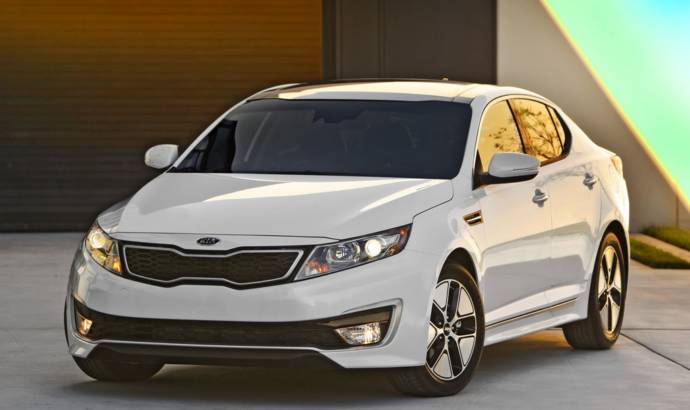
18 Nov 2010
0


